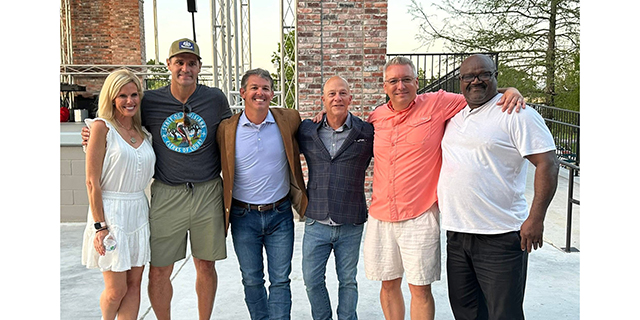Students stuff a need and learn for a career
Published 6:00 am Wednesday, January 24, 2018

- Steve Nugent flips through some of the finished products at CHS’ meat processing lab.
Lunch had just begun at Centerville High School, making it an ideal time to drop off a cooler full of deer and pork meat. Steve Nugent’s students had cleared out of the school’s meat processing lab to eat, and they’d be gone for another 30 minutes. After that, things would get busy.
At the school, students process around 450 deer a year, along with the meats of every other kind of animal local hunters bring in.
“We do deer, duck, chicken, hogs, we’ve even done nutria,” Nugent said. “We can make jerky, boudin, smoked sausage, summer sausage — you name it.”
And while all that processing fully sustains the program financially, it also trains students in the craft and business of meat processing, ultimately earning them an Industry-Based Certificate — a professional credential which allows them to directly enter the workforce.
“I’ve got 17 students that came through the program that are working meat all across South Louisiana still,” he said.
Nugent stepped outside to meet David Lile, who had just pulled his truck up to the back of the building. Lile slid a large, blue cooler from the bed of his truck onto a pushcart, and Nugent pulled open the lid. Inside was about 60 pounds of meat, mostly deer and some pork, on ice.
“I shot it this weekend on the Atchafalaya River, out on the swamp,” Lile said of the deer. “The pork, I bought.”
Lile himself worked in the lab as a CHS student in the 1980s, he said, and has been getting his meat processed there ever since.
Nugent said the program began in 1976, but has grown tremendously. He came on board in 2000, when the lab had just one or two seasoning blends. Now, an entire storage rack at the back of the lab holds several boxes of different flavor mixes he’s developed with students. Jalapeno cheese is the most popular, he said. A green onion one is the newest.
“We’re the only ones in the doggone state with that one,” he said. “It takes two years to get a spice balance right. And we’re not gonna turn it loose on the public until we’ve got it right.”
The only one that’s solely his is a special Steve’s Brisket Rub.
“It took me 22 years to get that one right,” he said.
Soon, students began trickling back in. They took up their posts at cleaning stations, deboning stations, and at grinding and stuffing stations.
“You feel like running the show?” Nugent asked senior Peyton Nash. “I need a point man — is that you?”
Nash said yes.
The students moved into action and the meat began moving through the lab. Alfred Daniels and Ethan Paul began trimming slabs of meat. Alayna Daniels began vacuum sealing coils of sausage. Andrew Johnson put casing onto the end of the sausage stuffer.
“That’s ‘Lucille,’ ” Nugent said of the machine. “That’s a piston stuffer, the only machine in here we named. That is a good machine. We used to be lucky to get 250 pounds of sausage in a day. With that, we’ll get about 1,500 pounds.”
All he wishes for now is more hours in the day. When the meat really begins to pile up, students can earn money staying after school to finish orders. Nugent recalled a 17-deer day that had them in the lab until 8 p.m. He said it’s particularly useful around Christmas time, when students are stretching to spring for gifts.
The students moved deliberately, methodically. Signs spray-painted on the wall encouraged students to “Never Rush!” and to “Cut Away” from themselves. Safety is
“Is anybody in a hurry?” Nugent called out, to which the students, uniformly, answered, “No.”
Safety, sanitatio, and equipment maintenance are at the core of the training.
“We want them to develop that inspector’s eye, to where you walk in and immediately start seeing what might be wrong or what needs adjusting,” Nugent said.
Right now, the class is in the heart of deer season, which starts in mid-October and runs through mid-March. Most of the clients are local hunters, bringing back their hauls from hunting trips across the Sportsman’s Paradise or in surrounding states. Nugent said they’ll do about 30,000 pounds this year. Six animals had come in that morning, and he was fielding more phone calls as the students worked around him.
“Hello, Mr. Robicheaux,” he said into his phone. When he hung up, he called out to the class, “We’ve got another deer coming!”
Johnson, Nash and Daniels have worked in the lab all four years they’ve been at the school. Though none of them have specific plans to pursue a processing career, they all found a lot of value in the program. Johnson plans to join the Air Force, but appreciates that this could be made into a career.
Daniels plans to go to college but believes the skills and certification earned in the meat lab might help her fund that.
“I’ve learned a lot about responsibility here, and how to do all of this basically on my own,” she said. “I can use this for work in college.”
“She’s top notch,” Nugent said. “She’s at the most important station — the vacuum packing. You vacuum pack poorly you’ll lose your sausage.”
Lile asked Nugent if the lab did smoked sausage.
“How much you want?” Nugent asked.
“Ten pounds,” Lile said.
“That’s it?” Nugent said, disappearing into the back.
“I’ve got to try it first,” Lile said, shouting.
Nugent came back with a frozen, perfectly vacuum-pac-sealed piece of sausage in his hand.
“You’ll get to know this smoke,” he told Lile. “It’s a light smoke, hickory. Throw that in with some red beans. Let me know what you think.”





